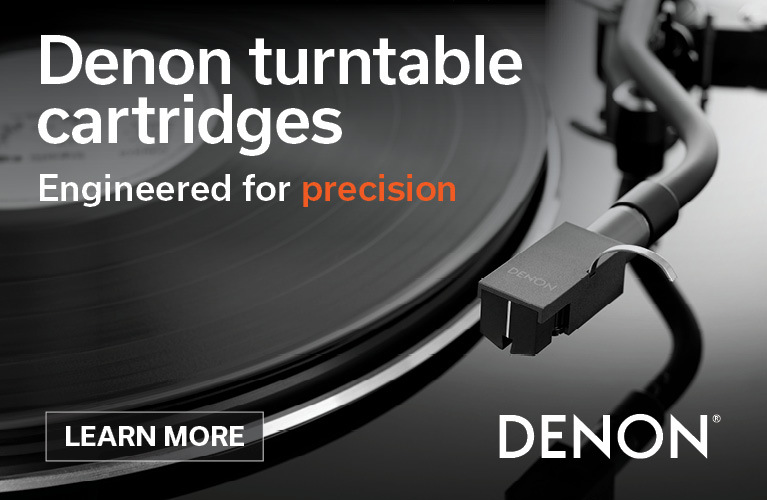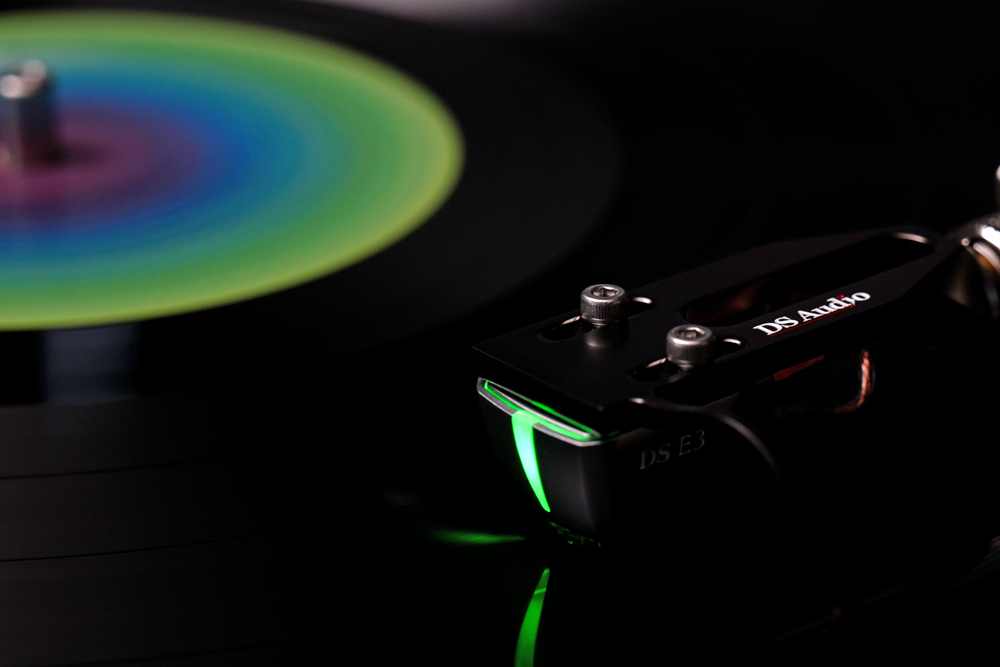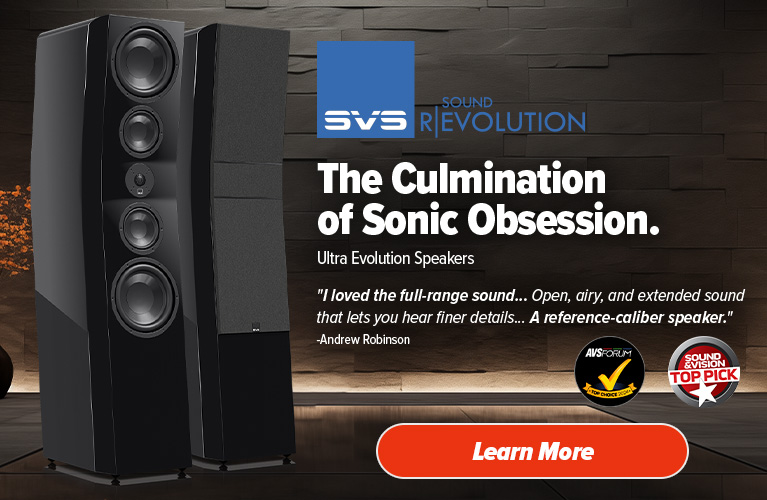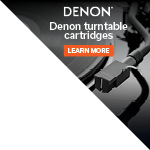Phono cartridges are a finicky lot, and especially the magnetic ones. If you want to make a mark in that area, you have to invest in the finest materials, meticulous assembly processes and eons of human expertise bordering on black magic. DS Audio dispensed with most of these complications by devising a line of optical cartridges that works in a completely different manner, follows completely different rules and achieves sound quality on a completely different level. The DS-E3 is DS Audio’s newest product and is a grand entry point to the company’s optical cartridge line-up.
I see the light!
Magnetic phono cartridges use a magnet and a coil to generate an electric signal through electromagnetic induction. The magnet and the coil are in close proximity to each other, with either the magnet or the coil connected to the stylus/cantilever assembly that moves (trembles, really) according to the shape of the record grooves, thus generating the electrical signal. We then amplify that signal by whatever means we can afford and hopefully hear it at the output of our hi-fi system.
In contrast to magnetic cartridges, DS Audio optical cartridges have an LED that shines brightly in the direction of a photodiode detector which is partially shaded by a small plate. This shading plate is connected to the stylus/cantilever assembly that moves (trembles, really) according to the record grooves. This changes the illumination of the photodiode, which then changes the current flowing through it and thus creates the electrical signal that we amplify and ultimately hear.
It is important to note that a magnetic cartridge is in essence a generator, while an optical cartridge is a modulator. These are two fundamentally different concepts. To give you an example of a generator, let’s imagine that you want to make some electricity in a remote location. You could install a dynamo, put a crank handle on it and then spin it by hand, which would probably end up being quite laborious for you. The more electricity you need, the harder you have to work the crank handle. As with all generators, you put in effort and you feel resistance.
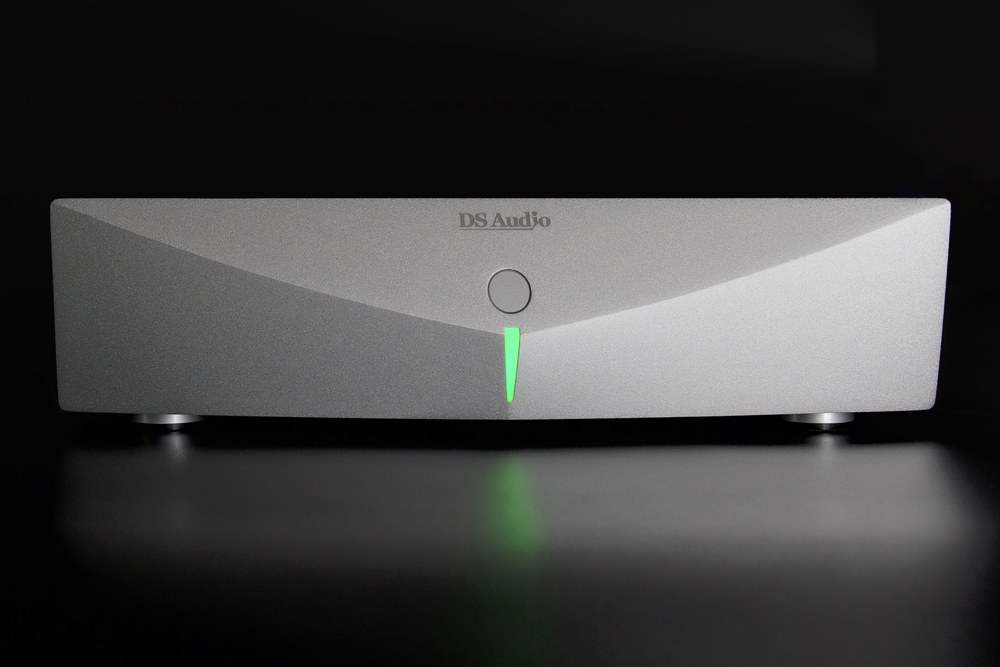
Alternatively, if your remote location is a windy one, you could install a wind turbine on your dynamo and let the wind spin it. In order to control the speed of your wind turbine, you could put a large sliding door in front of it (a bit impractical, but please stick with me). Then you could slide the door left and right to control the air blowing over the turbine. This sliding door is an example of a modulator. If it’s well designed and built, you’d be able to slide it easily, regardless of the wind speed. With modulators, you invest little or no effort and feel little or no resistance.
Substitute the wind with light and substitute the sliding door with a shading plate and you’ll come close to what DS Audio did with its cartridges. DS Audio’s shading plate is extremely light and experiences no physical feedback or resistance from the light it modulates. Consequently, it picks up even the tiniest acoustic details from the record and those details arrive faithfully at the photodiode detectors. The end result is a more accurate sound reproduction and reduced distortion.
There’s another thing. Every magnetic cartridge has to deal with magnetic hysteresis, which is a nonlinear memory effect of a magnetic material. This is very hard to get rid of and ultimately creates distortion. Needless to say, optical cartridges do not experience magnetic hysteresis, which reduces distortion even further.
Preparation
While waiting for the DS-E3 to arrive, I pre-charged my acoustic memory by listening to some very old friends in my record collection, quite a few of which I haven’t played for ages. Records and songs relegated to the “sounds better in digital” category saw the light of the day again, just in case something changes in that department. A distinguished member of the said category was the album Gustav Holst: The Planets, by William Steinberg and Boston Symphony Orchestra. I was eager to hear the optical cartridge rendition of this masterpiece.
Unavoidably, this review is an evaluation of a new technology as well as an evaluation of a new cartridge. That’s why I decided to compare DS-E3’s specifications with the specifications of my favourite Moving Coil cartridge. In many ways it turned out to be an “apples-to-apples” comparison:
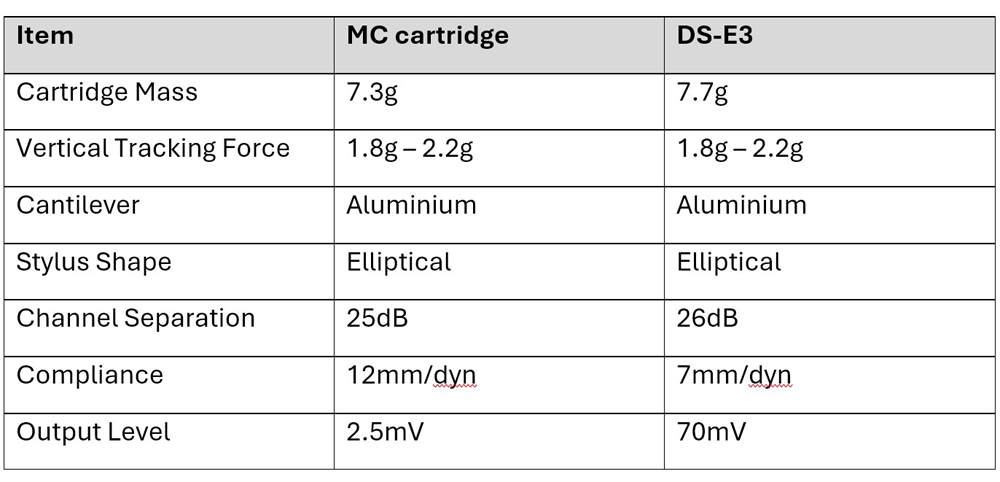
The table shows that DS-E3 is similar to my (High Output) MC cartridge in regard to mass, VTF, cantilever, stylus and channel separation. In other words, I was to find out what an optical cartridge with aluminium cantilever and elliptical stylus can do compared to an MC cartridge with aluminium cantilever and elliptical stylus.
Note the phrase “aluminium cantilever and elliptical stylus” typically implies an entry level cartridge, and DS-E3 is not an exception. My MC cartridge is the entry level model of its family and DS-E3 is the entry level model of the DS Audio line, although its price might suggest otherwise.
As for the differences, DS-E3’s compliance is significantly lower than my MC cartridge’s, which means that it requires a tonearm with a higher effective mass in order to have the same cartridge/tonearm resonant frequency. Accordingly, I prepared a heavier counterweight for the back of my tonearm and clip-on weights for the front.
The second point of difference is the output signal. Magnetic cartridges produce a few millivolts at most, and many deliver a lot less than that. The amplification of such small signals is challenging, not to mention the RIAA frequency correction. In contrast to that, DS-E3’s nominal output level is around 70mV, which is easier to amplify and also has a specific frequency curve which requires a simpler correction circuit. Because of that, optical cartridges use a specialized “equalizer” (AKA pre-preamplifier) to amplify the signal and flatten the frequency characteristic. You can obtain these equalisers from DS Audio and from a number of hi-fi equipment manufacturers who have adopted DS Audio’s published specifications.
The equaliser also has to supply power to DS-E3’s LEDs. That’s a modulator for you. It needs external power. The equaliser that came with DS-E3 has a pair of RCA inputs and a pair of RCA outputs. RCA outputs go into your preamplifier’s standard line input, of course. Nothing new to see there. What is new is the way the equaliser’s RCA inputs connect to the DS-E3 cartridge.
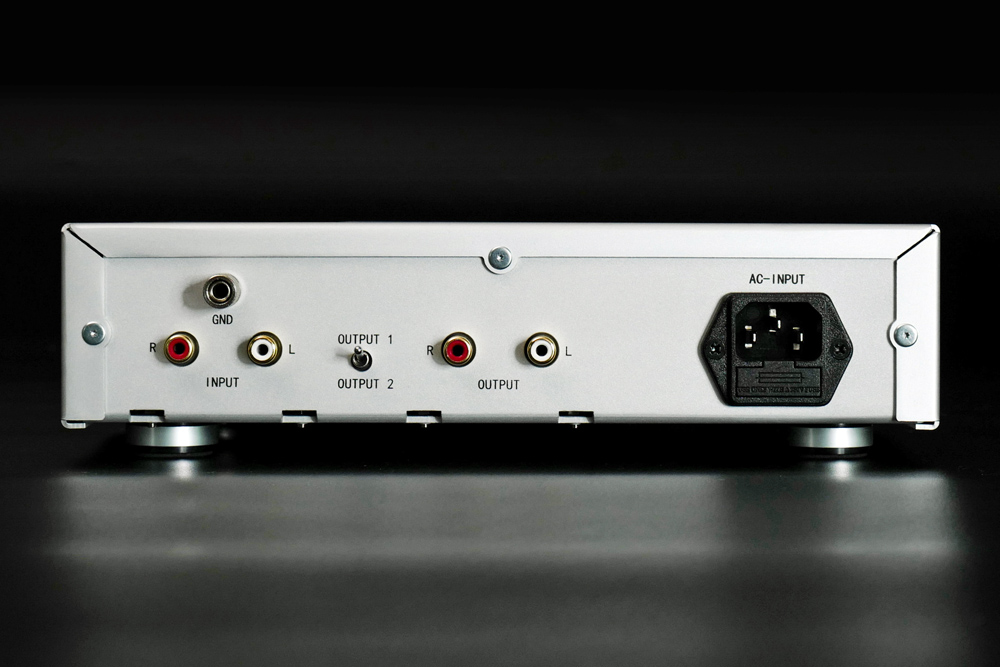
The ‘ground’ of the right input is positive by about 4.5V relative to the ‘ground’ of the left input. We’re talking about the outer contacts of the two RCA input connectors. The current flows from the right ground (about +4.5V), through the corresponding wire of the tonearm cable, arrives at the green pin of the DS-E3 cartridge, goes through the LEDs in the cartridge, comes out of the blue pin of the DS-E3 and, through another wire of the tonearm cable, arrives at the left ground, which is the real ground of the system (0V).
DS Audio specifies that 70-80mA of DC current runs through this circuit, which means that your tonearm’s wires and contacts must be in good enough condition to pass it without arcing, crackling or any other harm. I measured the resistance of my tonearm wires (without any cartridge installed!) and registered 0.35 ohms between the right RCA ground and the green connector in the headshell, and 0.34 ohms between the left RCA ground and the blue headshell connector. It was proved later that DS-E3 works fine with these resistances, so they should be well within an acceptable range. Some modern tonearms have wispy thin wires that might not be able to take 80mA, so please do your homework if you have one of those. Whatever you have, I recommend a thorough cleaning and re-setting of all contacts in the tonearm/cartridge ecosystem before installing DS-E3.
Unpacking, Installation, Setup
DS-E3 arrived together with its DS Audio equaliser, double-boxed, sturdily packaged and well protected from all sides. DS-E3 cartridge itself came in a heavy solid metal block with a Perspex lid that you detach by unscrewing four small countersunk screws. The pedantically minded among us might express a desire for a more cushioned arrangement that would cater for rough transport, but I doubt that DS-E3 would suffer from knocks in transport, however violent they may be. After all, the only moving part is the stylus/cantilever/shading plate assembly which is reputed to be significantly lighter than the lightest moving coil cartridge equivalent.
They say that there’s a thorny path to the stars, and DS-E3 was quick to remind me of that particular journey. When I tried to mount DS-E3 into my tonearm I realised that my headshell was of an old style type, i.e. with vertical side walls, which in this case were 20mm apart. That was never a problem before because all cartridges I came across were about 18mm wide. Not DS-E3. It’s chubby. It measures 19.7mm across without the stylus guard and full 22.3mm with the stylus guard on. Also, the stylus guard attaches around the top of the cartridge, which means that there’s no way you can mount DS-E3 into a 20mm wide old school headshell and keep the stylus guard on. Having no guard would have exposed the stylus to all kinds of peril during the setup process, so that idea was dismissed right away. Even if I did decide to install DS-E3 without the guard, I would have had only 0.3mm of sideways wiggle room for adjusting the cartridge, which is not enough.
Luckily (I thought), I found a 20mm wide “naked” headshell (i.e. with no vertical side walls) that was supposed to come to the rescue. But it did not. When I mounted DS-E3 into that headshell it became prohibitively tricky to align. Most cartridges I used in the past had a straight front edge which was easy to align against the gridlines on the protractor. DS-E3’s front is rounded, though, while its sides are straight. The width of this headshell and the width of the cartridge were almost identical and the headshell had no holes, so I could not see DS-E3’s sides, i.e. the only straight features I could use for the alignment. The solution that finally saved the day was an 18mm wide naked headshell, courtesy of a 3D printer and a carbon-fibre-reinforced filament. In this headshell, DS-E3’s sides were clearly visible from above and the cartridge was successfully aligned “lege artis”.
Many modern tonearms have integrated headshells, i.e. the tonearm and the headshell are manufactured as a single part. Many of these headshells are 20mm wide or wider. DS-E3 can certainly fit into these headshells, but it could create a challenge during the alignment process, similar to what happened to me. If your integrated headshell has no holes, or if its holes are too small or not in right places, you might not be able to see DS-E3’s sides well enough to do the alignment. One solution would be to engage a professional to setup the cartridge for you. Another solution could be that DS Audio redesigns DS-E3’s stylus guard and gives it a straight front, which (in conjunction with a hole right below the stylus) would certainly help with the alignment. Come to think of it, I might give it a go myself one day…
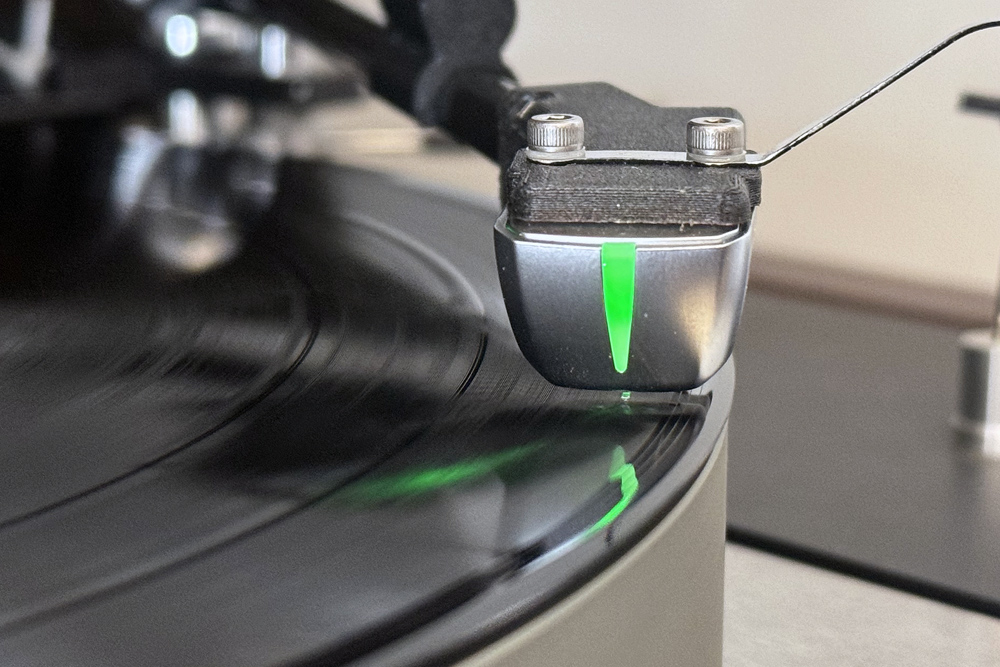
Ultimately, however, unless there are compelling technical reasons to the contrary, I would politely suggest to DS Audio to consider making their next generation of cartridges narrower and to give them a straight front. Please. Just for us old-timers who like to align stuff the good old way.
Unsurprisingly, the heavier counterweight and clip-on weights came in handy when setting up DS-E3. Without them, the tonearm’s effective mass was too low and the tonearm/cartridge resonant frequency was well above 20 Hz, resulting in thin bass and poor tracking. After the effective mass of the tonearm was increased to about 18g to 20g, the resonant frequency fell to 10 Hz to 11 Hz, bass came back and tracking improved.
To be exact, tracking became so good that DS-E3 did the dreaded “torture test” (last track on the side 1 of the Hi-Fi News test record) and passed it with flying colours. In the past, so many cartridges produced such unpleasant fuzz there that I almost stopped trying. Playing that notorious track DS-E3 produced less fuzz than other cartridges made in the previous track or even the one before that. Good on you, DS Audio! Very well done indeed.
DS-E3’s equaliser’s outputs are connected to the equaliser’s case, and the case is earthed through the equaliser’s power connector. This seemingly innocent statement should be on your mind if you decide to keep a magnetic cartridge in your hi-fi system. For example, let’s say that your turntable has two tonearms: one with DS-E3, and the second one with a magnetic cartridge. Or you might have two turntables, two tonearms and two cartridges, one of which is DS-E3 and the other one is magnetic. Let’s say that your magnetic cartridge is plugged into the phono input of your preamplifier and that DS-E3 is plugged (via the equaliser) into one of the preamp’s line inputs. Typically, preamplifiers are earthed at the thumbscrew next to the phono input, in order to reduce the hum. Now remember that DS-E3’s equaliser’s outputs are directly connected to the equaliser’s case, and that the case is earthed through the equaliser’s power connector. This constitutes another path to the earth, which can create a ground loop and increase the hum when you play records via the magnetic cartridge.
The described situation will not eventuate if you decide to just use an optical cartridge to play vinyl records, but if you retain a magnetic cartridge as an alternative/comparison/demo, you should do some pre-planning in order to avoid ground loops and hum. To DS Audio, I would suggest that they should add a ground lift or a “bridge/RC lift” as a ground loop avoidance measure. Come to think of it, this could be the first mod for someone to try on the equaliser…
Talking about hum, I have not heard any from DS-E3. Not a peep! What I did hear was white noise “hiss” at higher amplification levels, where it did not affect the sound. Please let me explain.
I play music mostly with the volume knob at 9-10 o’clock, depending on the track, genre and mood. Very rarely I turn the volume higher than 11 o’clock. That is, when I play music. However, for testing purposes, I can set the volume to whatever I need. So, in the past, when I had the magnetic cartridge as the source, with no record on, and with the volume knob at 11 o’clock, the hum from the AC mains was just barely detectable. At 12 o’clock it became clearly audible. At 3 o’clock and above it filled the room, but I never play records at those volumes, so it’s all fine. Now, with DS-E3 in the system, there’s no hum at any volume, at 11 o’clock the background is quiet as a mouse, but as soon as I turn the volume to 12 o’clock I start hearing white noise, which becomes quite audible when you reach 3 o’clock. With volume knob at the maximum, white noise is unmistakeable. Again, I never play at those levels, so it’s all good.
White noise did not come as a great surprise. Noise is inherent to photodiodes in analogue circuits of any kind. Noise is also a vastly complex topic which I’ll do my best to simplify for you as well as for me by boiling it down to a single measurement. With that objective, I attached a voltmeter at the very end of my hi-fi chain, i.e. across the speaker terminals, and measured the AC voltage there. No music was played. Here are the results:
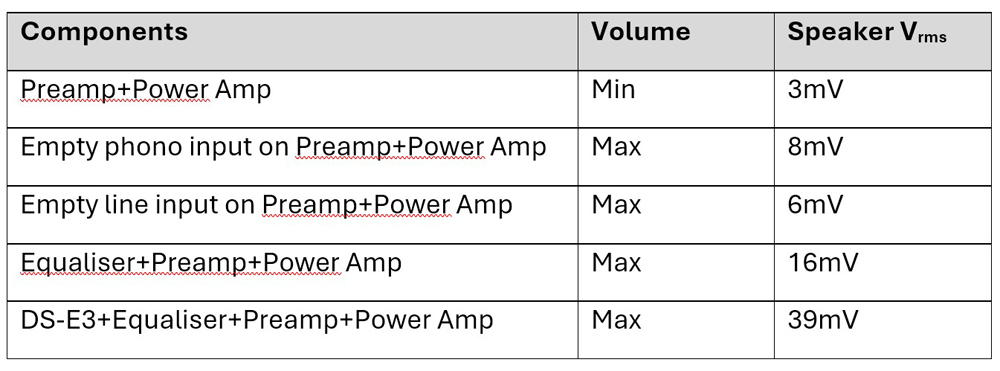
The table shows that my preamplifier and the power amplifier, with volume on the minimum, just by themselves produce 3mV of noise at the speaker terminals. This is the “noise floor” of my hi-fi system. This is the best I can achieve for what I have.
When I selected the phono input (without anything plugged into it) and set the volume knob to the maximum, I got 8mV at the speaker terminals, which means that the magnetic phono circuit adds 8-3=5mV to the overall noise.
When I selected a line input without anything plugged into it and set the volume knob to the maximum, I got 6mV at the speaker terminals, which means that the line amplification circuit adds 6-3=3mV to the overall noise.
Then, I selected the preamplifier’s line input that had the equaliser plugged into it, but DS-E3 was not plugged into the equaliser. For this combination, the voltmeter showed 16mV at the speaker terminals. This means that the equaliser contributes 16-6=10mV to the overall noise.
Lastly, I plugged DS-E3 into the equaliser and measured again. The voltmeter showed 39mV at the speakers, which means that the cartridge contributes 39-16=23mV to the overall noise.
I admit that this is a pretty basic measurement method which does not take into account important things like noise spectrum and power. On the other hand, you can easily do it yourself with a very cheap instrument and it gives you a useful indication how DS-E3, or any other component, performs in regards to noise or hum in your system.
One result I did find intriguing was the amount of noise that the equaliser adds to the final result. Here is why: I unplugged DS-E3 from the equaliser, selected the preamplifier input that the equaliser was plugged into, and the noise at the speakers increased by 10mV. When I selected the phono input with nothing attached to it, the noise at the speakers increased by 5mV. Magnetic phono inputs have to be amplified much more than the input from an optical cartridge, and the general rule is that the higher the amplification, the higher the noise, for the same level of quality. According to this rule, more noise should be expected in the magnetic phono circuit than in the circuit with the optical cartridge equaliser.
I stand to be corrected, but from these measurements I can only conclude that the version of DS Audio equaliser that comes with DS-E3 could be improved in regard to noise, if only as a matter of principle, regardless of the fact that the noise is inaudible at normal listening levels. This equaliser performs just one simple function, but costs twice as much as my considerably more complex mid-range preamplifier from a firm of a good repute, and yet it creates twice as much noise as the magnetic phono circuit. I’m sure that DS Audio can easily do better. Wouldn’t it be nice if white noise became audible at 2-3 o’clock instead of 12?
As for the level of noise produced by DS-E3 cartridge itself, I was impressed that there wasn’t more of it, considering the inherent noisiness of analogue photodiodes. Without packing more electronics into the cartridge and without the ability to obtain a differential signal from it, this is probably the best anyone could achieve at this stage.
Listening Impressions
And then we come to the stars…
A quick glance through the pile of scribblings written down by my trembling hand reveals an old man unaccustomed to the levels of excitement he was subjected to: “Instruments and voices acquire realism and vibrancy on a completely new level”… “Soundstage is enormously wide, deep, rich and precise”… “There’s no doubt anymore where each instrument is”… “No coloration to speak of anywhere”… “Break-in: All traces of any harshness are gone after just 2-3 hours”… “The improvement is most remarkable with live recordings, which I love even more now”.
I could go on and on, but what DS-E3 achieved is the acoustic equivalent of this: Imagine that you’re sitting on a couch in a room that has a sun-drenched balcony. A light curtain is hanging at the open balcony door. You can see that there are people on the balcony. You can see the clothes they’re wearing, their body shapes and face contours, albeit through this light curtain. Now imagine that all those people have suddenly entered the room. The curtain is behind them. Now you can see the stiches on their garments, the exact features of their bodies and blemishes on their skin. That’s exactly what DS-E3 did with the sound of my vinyl records. Now I know what they really contain, warts and all may be, but most importantly, there’s an additional abundance of details and beauty that bring a smile to one’s face and joy to one’s heart.
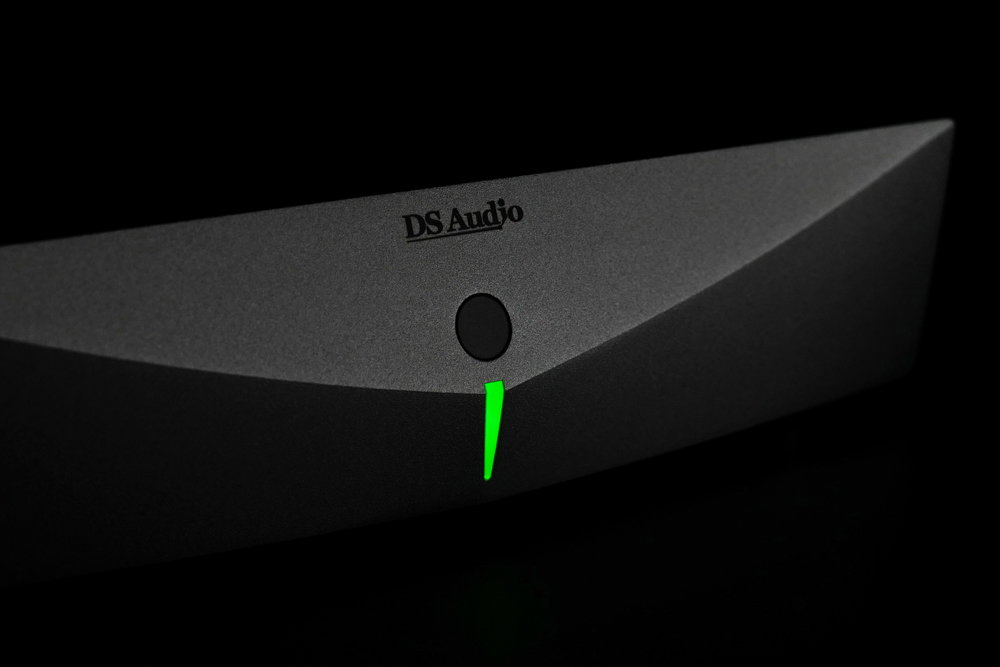
Here are some customary examples to give you a better idea of what I mean. For me, “Alone, Alone and Alone” from the album Taro’s Mood used to be a challenging listen because of its Post-Bop esoteric nature. I use this track as a test for record noise because at the beginning there’s a piano on the right and from the left you just hear the noise. However, with DS-E3 in the chain, every “tarreee”, “tarraaa” and “tari-bouah” of Hino Terumasa’s trumpet became so alive and striking that I found myself genuinely enjoying them, to my great surprise. DS-E3 revealed the richness of detail that finally revealed this album’s dreamy, meditative soul to me. Play it again, E3!
“Times Lie” from the album The Best of Stan Getz is another noise test. There is a dubbing noise of the keyboards in the right channel during the first 10 seconds. This track has great bass, cymbals, sax (of course) and bells. I relished them all, patiently waiting for the 3:30 mark, when the “cow dancing Samba” started and for one full minute showed off those humble ancient percussions – the bells. And DS-E3 turned that cow into a Samba champion!
“La Fiesta” from the same album demonstrates what a virtuoso can do with two pairs of castanets, but I never experienced them like this before. They are deep back in the soundstage, the deepest I ever heard. Yes, the sax is there, drums too, all with the clearly defined sound and the place on the soundstage I learned to expect from DS-E3, but the real gem are the castanets. The next track, “Street Tattoo”, comes almost like a relaxing cigarette after the main event.
“Song for the Newborn” from the album Paris-Concert by Circle is a bass test. Literally. There’s nothing else there. To its credit (or more appropriately, high distinction) DS-E3 delivered the tightest, punchiest bass I ever heard on vinyl or otherwise. And I’m happy to report that I heard less noise than from the same track on Tidal!
At the end of the side 1 of Joan Baez in Concert, Part 2 is the “Manha de Carnaval/Te Ador” medley. This a tough tracking test, for two reasons. First, it’s the innermost track on a record, which is always a challenge in itself. Secondly, I don’t know what Joan Baez was doing on the stage, but my impression is that she boosted her already soaring voice by coming closer to the microphone the louder she sang. She must have also bumped into a microphone or there’s a goof somewhere in the recording chain because her voice skips from left to right and back at random. Whatever happened created extreme dynamics that many cartridges find impossible to tame. DS-E3 sailed through it all with no clipping. Very good!
When playing “Bach: Suite No.2 in D Minor for Unaccompanied Cello (6 – Gigue)”, from CBS’s promotional album The New Superstars, DS-E3 delivered an unsurpassed, uncanny presence of Yo-Yo Ma’s cello, a dead-quiet background and clear breathing sound of the bow flowing across the strings. Other than actually sitting in the live audience, I’m not aware of anything else that would bring me closer to this performance.
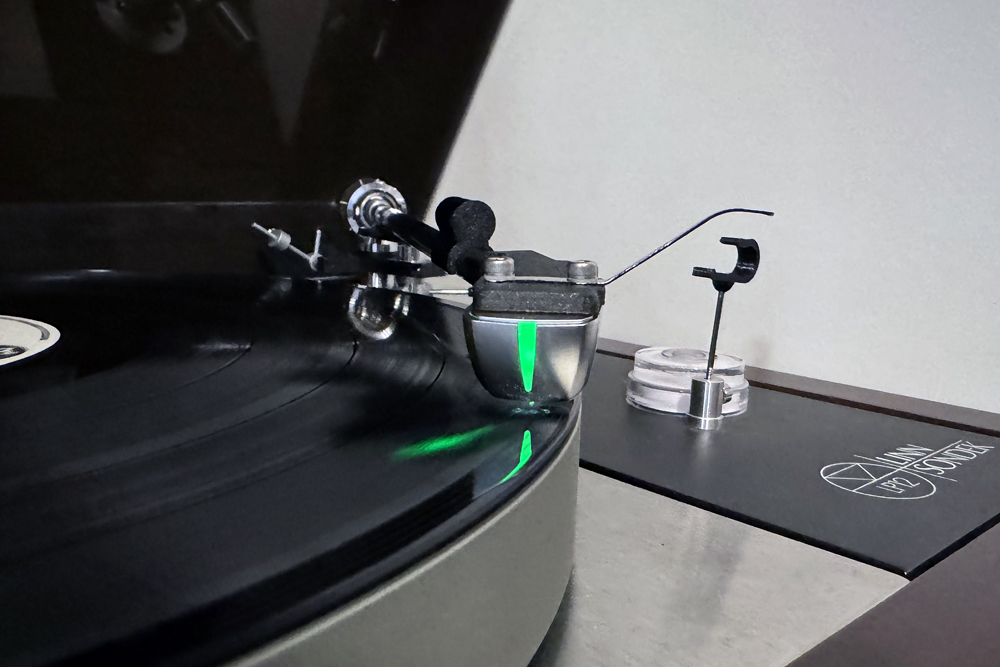
By now, you have probably picked up on the main theme: DS-E3 is revealing. A revelation, no doubt, and mostly because it’s revealing. One word of caution, though: New pressings and reissues, such as the orange-coloured Live at Fillmore East by Allman Brothers Band can sound too bright, too aggressive. A case in this point is “Statesboro Blues” from the said album. I found myself reaching for the remote, turning down the volume, dampening the treble and ultimately changing the record. I have no idea why new vinyl records would have to come with this kind of sound, but many do. Luckily, I can always revert to the old masters.
Lastly, after years of listening to a CD edition of Holst: The Planets by William Steinberg and the Boston Symphony Orchestra, I put the vinyl version on the turntable and let it rip. And rip it did. DS-E3 turned “Mars” into a complete Stalingrad! What used to be an indication became an assertion. What used to be “just” an image of horrific destruction became a visceral experience of bestial annihilation of everything human. On the other side of the spectrum, “Jupiter” became a frolicking festival of playful instruments. DS-E3 effortlessly uncovered ample details that made each track of this record so remarkable and so beautiful that I played the whole album multiple times in a row. Never mind the CD; I love this “gas light”.
Conclusion
Perhaps it is fair enough that a hi-fi manufacturer should price its product according to the quality of the sound it produces. On the other hand, many potential buyers might find DS-E3’s price tag out of their reach, which would be a pity. Again, I stand to be corrected, but LEDs and photodiodes I’d expect to see if I opened an optical cartridge should be reasonably priced electronic components, optical cartridges’ labour costs and yield losses should be more favourable when compared with the fiddly fine wire winding and testing that magnetic cartridges must go through. If a competitor picks up this technology, we could expect some pricing differentiation. Until then, DS Audio remains in an enviable position of having a great product and being able to charge for it according to the quality of its sound alone.
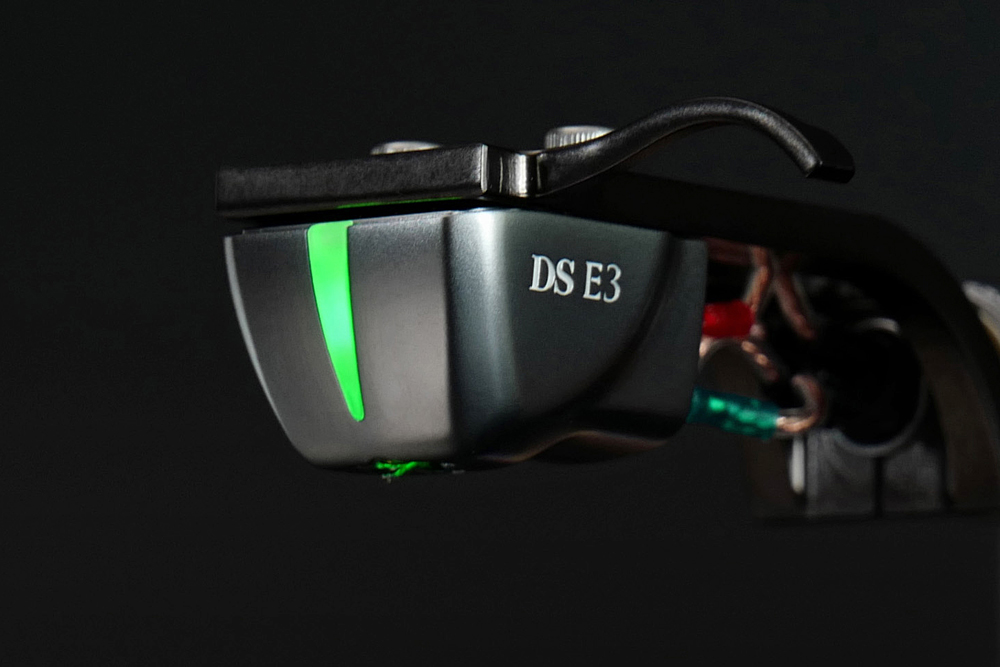
As for the sound it produces, the only conclusion I can possibly make is that DS-E3 is a game changer, even if DS Audio’s marketing department says so. It truly is. To those of you who can afford to acquire this game changer I can only recommend that you go out and buy it. (Do your homework first: prepare, measure, check, clean…) DS-E3 is worth it all. It will transform the relationship between you and your records. I wouldn’t be surprised if you binge-play your whole vinyl collection. It does that to you.
As for myself, with DS-E3 now as part of my reference system, the star of the show is vinyl again, no question.
…Vedran Simunovic
www.soundstageaustralia.com
Associated Equipment
- Turntable – Linn Sondek LP12, Hercules power supply
- Tonearm – Custom made, based on Grace 707, carbon fibre tube, custom headshell
- Preamplifier – Rotel RC-1550
- Amplifier – Custom made, based on Phase Linear 700 Series Two
- Cables – Interconnects: Custom made, twisted pair + shield, asymmetrical; Speaker cables: Custom made, helical geometry
- Speakers – Magnepan MMG
DS Audio DS-E3 Optical Cartridge
Price: AU$4500 (includes Equaliser)
Australian Warranty: 24 Months
Australian Distributor: Absolute Hi End
+61 488 777 999
www.absolutehiend.com
Digital Stream Corporation
4-50-40, Kamitsuruma-Honcho
Minami-ku, Sagamihara
Kanagawa 252-0318
Japan
+81 427 47 0900
https://ds-audio-w.biz/

